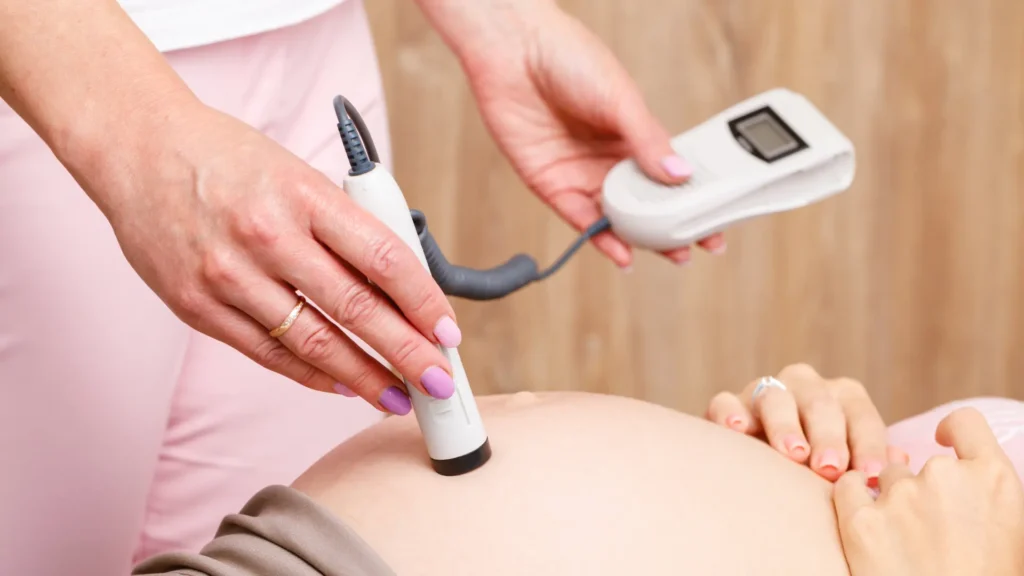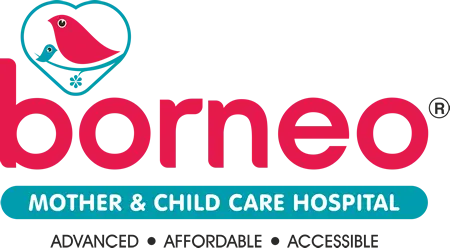Pregnancy is naturally a time filled with hope and excitement, but receiving a diagnosis of a “high-risk” pregnancy can understandably introduce feelings of uncertainty and concern. Knowing that your pregnancy requires extra attention often leads to questions about what this means for you and your baby’s health. While it’s normal to feel apprehensive, there’s a powerful tool we use to navigate these challenges safely: vigilant, regular monitoring.
My name is Dr. Vrushali Pillai, as a Senior Consultant in Obstetrics & Gynaecology at Borneo Hospital, Thane (part of the Borneo group serving Thane, Nashik, Chhatrapati Sambhaji Nagar, and Raipur), my priority is always a safe and positive birth experience for every mother and baby. We understand the anxieties associated with high-risk situations, and we want to assure you that a key element in ensuring the best possible outcome is a system of careful, ongoing checks and assessments. This article will delve into the crucial importance of Regular Monitoring in High-Risk Pregnancies, explaining what it involves and why it is absolutely essential for proactive management and safety.
What Does “Monitoring” Really Mean in a High-Risk Context?
When we talk about monitoring in relation to high-risk pregnancies, we mean something much more intensive than standard antenatal check-ups. It’s a proactive, often more frequent, and detailed process of surveillance. Think of it as a dedicated safety net, carefully woven with regular assessments and specialised tests.
The primary goal of this intensified monitoring is early detection. It’s about identifying any potential issues or deviations from the expected course – in either the mother’s or the baby’s health – at the earliest possible stage. This allows your medical team to intervene promptly and effectively, significantly improving the chances of a healthy outcome. It is fundamentally different from the monitoring schedule for a low-risk pregnancy due to the increased potential for complications.
Why is Regular Monitoring So Vitally Important?
Consistent and thorough monitoring is non-negotiable when managing high-risk pregnancies for several critical reasons:
- Early Detection of Complications: This is perhaps the most significant benefit. Regular checks allow us to catch the first subtle signs of serious complications like pre-eclampsia (e.g., rising blood pressure before severe symptoms appear), uncontrolled gestational diabetes, infections, or issues with foetal growth before they escalate into emergencies. Early detection often means simpler, more effective treatment.
- Tracking Progression of Known Conditions: If you have a pre-existing health condition (like diabetes, thyroid issues, or hypertension), regular monitoring in high-risk pregnancies helps track how your condition is responding to the physiological changes of pregnancy and how the pregnancy is affecting your condition. This allows for timely adjustments in your medication or management plan.
- Assessing Foetal Well-being: Monitoring provides a direct window into how your baby is doing. Techniques like ultrasound scans, Doppler studies, and heart rate monitoring help assure us that the baby is growing appropriately, moving well, and receiving adequate oxygen and nutrients via the placenta. It confirms the baby is coping well.
- Guiding Timely & Appropriate Interventions: The data gathered from monitoring is what informs crucial decisions. Does medication need adjusting? Is stricter bed rest required? Is it time to administer steroid injections to help mature the baby’s lungs in anticipation of preterm birth? Is delivery becoming necessary for the safety of mother or baby? Monitoring provides the objective evidence needed to make these critical calls at the right time.
- Providing Reassurance: While the frequency of tests can sometimes feel intense, positive monitoring results showing stability and well-being can provide immense reassurance to expectant parents, helping to alleviate some of the anxiety associated with a high-risk diagnosis. Knowing you’re being watched closely can be comforting.

Key Components of Regular Monitoring in High-Risk Pregnancies
The specific monitoring schedule and tests will be personalised based on your individual situation, but here are the core components typically involved:
1. More Frequent Antenatal Visits:
- You can expect to see your obstetrician much more often than in a low-risk pregnancy – perhaps every two weeks, weekly, or even more frequently as your pregnancy progresses or if concerns arise. This allows for regular assessment and quicker responses to any changes.
2. Detailed Maternal Monitoring:
- Blood Pressure (BP) Checks: Frequent and accurate BP readings are essential, particularly for detecting or managing pre-eclampsia and other hypertensive disorders.
- Urine Tests: Routinely checked for protein (a key sign of pre-eclampsia), glucose (to monitor blood sugar control in diabetes/GDM), and signs of urinary tract infections, which are more common in pregnancy.
- Weight Monitoring: Tracking your weight gain helps ensure it is appropriate for your specific circumstances.
- Symptom Review: Each visit includes careful questioning about any symptoms you might be experiencing, such as headaches, vision changes, swelling, pain, bleeding, or changes in baby’s movements. Your reporting is a vital part of monitoring.
- Targeted Blood Tests: Depending on your condition, regular blood tests might be needed to monitor blood sugar control (HbA1c, frequent self-monitoring), kidney and liver function, haemoglobin levels (for anaemia), thyroid hormones, or other specific markers.
3. Intensive Foetal Monitoring:
This focuses directly on assessing your baby’s health and development inside the womb.
- Ultrasound Scans (More Frequent & Detailed): Ultrasound is a cornerstone of regular monitoring in high-risk pregnancies. Beyond just ‘seeing the baby’, it’s used for:
- Growth Scans: Measuring specific parts of the baby to estimate weight and track growth over time, identifying potential FGR (growth restriction) or macrosomia (excessive growth).
- Amniotic Fluid Index (AFI): Measuring the amount of amniotic fluid, as too little (oligohydramnios) or too much (polyhydramnios) can indicate underlying issues.
- Placental Assessment: Checking the placenta’s position (important for conditions like placenta praevia), appearance, and maturity.
- Biophysical Profile (BPP): A comprehensive assessment combining an ultrasound evaluation (checking foetal breathing movements, gross body movements, muscle tone, and amniotic fluid volume) with results from an NST (see below). This gives a score indicating foetal well-being.
- Doppler Ultrasound: This specialised technique, available at Borneo Hospital using our advanced equipment, measures the speed and pattern of blood flow in the umbilical cord and key blood vessels in the baby (like in the brain). Abnormal patterns can indicate placental insufficiency or foetal stress.
- Non-Stress Test (NST) / Cardiotocography (CTG): This common test involves placing sensors on your abdomen to record the baby’s heart rate and its pattern, particularly how it responds to the baby’s own movements. A ‘reactive’ NST, showing specific accelerations in heart rate with movement, is generally reassuring.
- Foetal Movement Counting (‘Kick Counts’): From around 28 weeks, you will likely be asked to pay close attention to your baby’s movements daily. Your doctor will give specific instructions on how to count movements over a set period. A significant decrease in your baby’s usual pattern of movement should be reported immediately. This maternal observation is a really vital component of monitoring.
4. Specialised Tests (As Needed):
- Additional tests like a detailed foetal echocardiogram (a specialised ultrasound focused solely on the baby’s heart structure and function) may be recommended for specific concerns.
How Monitoring Guides Critical Management Decisions
It’s crucial to understand that monitoring directly influences care. The results guide treatment adjustments and major decisions, including the timing of delivery. For instance:
- If BP readings consistently rise despite medication, delivery might be recommended sooner.
- If blood sugar levels remain high in GDM despite diet changes, medication may be initiated or adjusted.
- If an NST or BPP indicates potential foetal distress, further evaluation or immediate delivery might be necessary.
- If ultrasound shows significantly slowed growth (FGR) combined with concerning Doppler results, delivery might be planned, often after giving steroids to help mature the baby’s lungs.
Regular monitoring in high-risk pregnancies allows the medical team to make these crucial decisions proactively, based on objective evidence, rather than reactively after a problem has become severe.

The Role of Technology and Expertise at Borneo Hospital
Providing effective monitoring requires both advanced technology and skilled professionals. At Borneo Hospital:
- Advanced Tools: We utilize high-resolution ultrasound machines with detailed Doppler capabilities, sophisticated foetal heart rate monitors (CTG machines), and have comprehensive in-house laboratory services for quick and accurate test results.
- Experienced Team: Our obstetricians have extensive experience in managing high-risk pregnancies. Our sonographers are skilled in performing detailed foetal assessments. Our nursing staff are trained in careful observation, and our paediatric team, including myself, works closely with obstetrics to interpret foetal well-being data and plan for neonatal care. This technology is facilitative towards better assessment.
This combination ensures that the monitoring provided is thorough, accurate, and expertly interpreted.
Your Crucial Role in the Monitoring Process
Monitoring is a partnership, and you play an essential part:
- Attend All Appointments: Your presence at every scheduled visit is critical.
- Perform Daily Kick Counts: Follow your doctor’s instructions diligently.
- Report Symptoms Immediately: Never hesitate to call your doctor or the hospital if you experience any warning signs or feel something isn’t right. Early reporting save lives.
- Follow Self-Monitoring Instructions: If asked to monitor blood sugar or blood pressure at home, do so accurately and report results as requested.
- Communicate Openly: Ask questions, express concerns, ensure you understand the monitoring plan.
Regular Monitoring in High-Risk Pregnancies is far more than just extra check-ups; it is the fundamental strategy for safeguarding the health of both mother and baby when potential risks are higher. It allows for early detection of complications, guides timely and appropriate interventions, helps personalise care plans, and can provide valuable reassurance along the way. It is the cornerstone upon which safe management is built.
At Borneo Hospital, our commitment is to provide this vigilant, expert monitoring using the best available technology and a compassionate, experienced team. We partner with you, ensuring you are informed and involved. Trust in the process, attend your appointments diligently, and communicate openly with your care team. This proactive approach is key to navigating your high-risk pregnancy journey safely and achieving the best possible outcome.



